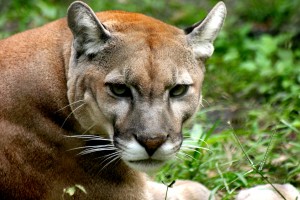POPULAR FLORIDA PANTHER IS EUTHANIZED AT PALM BEACH ZOO
Colin Patrick, 17-year-old Florida panther (Photo by Keith Lovett)
West Palm Beach, Florida, March 7, 2012 – The Palm Beach Zoo in West Palm Beach Florida has euthanized “Colin Patrick”, a 17-year-old Florida panther (Puma concolor coryi) that has been a favorite with zoo visitors throughout his life. Colin was born at the Palm Beach Zoo on St. Patrick’s Day in 1995 and lived in the Florida Wetlands section of the zoo.
Dr. Genevieve Dumonceaux, the zoo’s Clinical Veterinarian said, “Colin was recently diagnosed with a tumor that was compressing his spinal cord in the area between his shoulder blades. This was affecting his ability to use his rear legs and he became unable to walk. Examinations also showed advanced bone disease in the spine. Due to the inevitable progression of this problem and the lack of feasible and effective long term therapies for this geriatric panther, the staff of the Palm Beach Zoo animal department made the difficult decision that Colin should be humanely euthanized.”
Keith Lovett, Assistant Director of the Palm Beach Zoo said, “Very few animals in the history of the Palm Beach Zoo have touched the lives of as many guests and staff as Colin. In addition to the important role Colin played as an ambassador for his endangered species, he delighted zoo visitors with his playful demeanor and cunning personality. He will be sorely missed.”
Colin was the offspring of George, a Texas Cougar, and Tayke, a Florida Panther and was hand raised by Palm Beach Zoo staff and volunteers. He was one of only a few animals currently in captivity to have Florida panther lineage. His favorite activity was “stealth stalking” guests, volunteers and staff. His favorite foods were fish and large rodents.
Florida Panther Facts
RANGE: At one time distributed throughout the state of Florida, now most of the surviving animals are found in the Florida Panther National Wildlife Refuge, Big Cypress National Preserve, and Everglades National Park.
HABITAT: Varied, including swamp, forest and ranchland.
DIET: They prefer to feed on wild pigs and white-tailed deer, but will also hunt raccoons, armadillos, and small alligators.
PHYSICAL CHARACTERISTICS:
Size: Reach 6 to 7 feet from nose to tail.
Weight: Adults can weigh between 70 and 150 pounds.
Color: Uniform light brown coat with whitish underbelly.
Longevity: Up to 12 years in the wild; longer in captivity.
REPRODUCTION:
These cats are usually solitary but come together during breeding season. Females generally give birth to a litter of 1 to 4 kittens after a gestation period of 90-95 days. They usually breed every other year, but females will come into estrus sooner if the litter is lost. The young are born with spots that tend to fade after 6 months of age. Young typically nurse for 2 months and will stay with the mother for up to 2 years.
GENERAL INFORMATION
· The Florida panther is the official state animal of Florida.
· This is a subspecies of the puma found ranging from the western United States to South America. Other names for panthers are cougar, mountain lion, and catamount.
· They have a keen sense of smell and excellent eyesight. They can run up to 35 mph but only for short distances (~200 yards).
· These animals need large territories. Each individual male needs approximately 200 square miles of territory, and females up to 75 square miles. Panthers may range 10-15 miles in a single day.
CONSERVATION INFORMATION
Florida panthers are listed as an endangered species by the U.S. Fish & Wildlife Service. In 1993, the population was estimated to be 30 to 50 animals and current numbers are believed to have only reached 100. Radio collar monitoring and camera traps are being used to help save the Florida panther. The main threats to their existence are habitat loss and fragmentation as well as automobile collisions.


